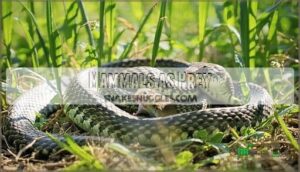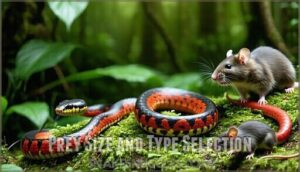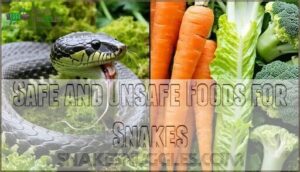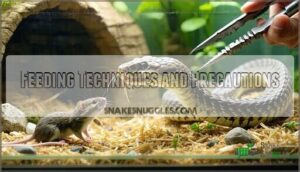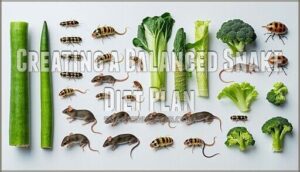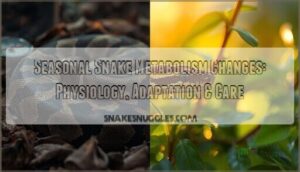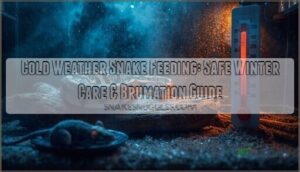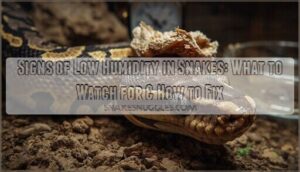This site is supported by our readers. We may earn a commission, at no cost to you, if you purchase through links.

You might think they’d nibble on a salad now and then, but these slithery creatures are strictly carnivorous.
Their digestive systems lack the enzymes needed to break down plant matter, so even if they accidentally swallowed a leaf, they’d gain zero nutritional value from it.
Think of snakes as nature’s ultimate meat-eaters – their bodies evolved specifically to hunt and digest other animals.
From tiny insects to large mammals, their menu consists entirely of protein-packed prey.
Understanding what makes snakes tick nutritionally reveals some fascinating secrets about their hunting strategies and survival tactics.
Table Of Contents
- Key Takeaways
- Snake Diet Overview
- Do Snakes Eat Vegetables
- Types of Prey for Snakes
- Wild Snake Diets and Prey Selection
- Nutritional Needs of Snakes
- Safe and Unsafe Foods for Snakes
- Why Snakes Don’t Eat Vegetables
- Feeding Techniques and Precautions
- Common Mistakes in Snake Feeding
- Creating a Balanced Snake Diet Plan
- Frequently Asked Questions (FAQs)
- Conclusion
Key Takeaways
- You can’t feed your snake vegetables – they’re obligate carnivores with digestive systems that completely lack the enzymes needed to break down plant matter, making vegetables nutritionally useless and potentially harmful.
- Your snake’s anatomy is built exclusively for meat – their flexible jaws, backward-curved teeth, and short digestive tract evolved specifically to hunt and process whole prey animals, not to chew or digest plant fibers.
- You’ll harm your snake’s health with plant-based foods – feeding vegetables can cause digestive blockages, malnutrition, and serious complications since snakes require complete animal proteins, proper calcium-to-phosphorus ratios, and nutrients only found in prey.
- You should stick to appropriate prey like rodents, birds, and fish – frozen-thawed mice and rats provide the safest, most nutritionally complete meals that match your snake’s natural dietary needs and prevent feeding-related injuries.
Snake Diet Overview
If you’ve ever wondered whether your pet snake might enjoy a carrot snack, you’re in for a surprise.
Snakes are strict carnivores with digestive systems designed exclusively for meat, making them nature’s ultimate protein specialists who can’t process vegetables at all.
Snakes are living meat-processing machines—vegetables simply don’t compute in their carnivorous world.
Carnivorous Lifestyle
Why do snakes stick to such a strict carnivorous diet? These reptiles are obligate carnivores, meaning they’re hardwired to survive exclusively on meat.
Through millions of years of evolutionary pressures, snakes developed incredible prey specialization that makes them nature’s ultimate hunters.
Here’s what makes their carnivorous animals lifestyle so effective:
- Digestive adaptations perfectly tuned for breaking down animal proteins and fats
- Nutrient acquisition systems that extract maximum value from each meal
- Hunting instincts that help them locate and capture live prey efficiently
- Metabolic efficiency allowing them to survive on infrequent, large meals
Lack of Digestive Enzymes for Plants
Why can’t snakes handle your garden salad? Their digestive systems lack the specialized enzymes needed for plant matter digestion.
This enzyme deficiency isn’t accidental – it’s carnivore adaptation at work. Unlike herbivorous animals, snakes haven’t evolved the complex digestive machinery for plant-based diet processing.
Their digestive system creates nutritional absences when faced with vegetation, leading to digestive inefficiency. Think of it like trying to run diesel fuel through a gasoline engine – it simply won’t work.
| Snake Digestion | Plant Requirements |
|---|---|
| Protein enzymes only | Cellulase enzymes |
| Short digestive tract | Extended gut length |
| Acidic breakdown | Alkaline processing |
| Single stomach | Multiple chambers |
| Carnivore bacteria | Herbivore microbes |
Specialized Jaws and Teeth
Beyond lacking proper enzymes, snakes possess jaw flexibility and specialized anatomy that screams "meat only." Their incredible skull adaptations allow independent jaw movement, creating swallowing mechanisms that can handle prey twice their head size.
You’ll notice their teeth aren’t designed for grinding a plant-based diet – they’re curved inward for prey grasping and guiding whole animals down their throat.
Here’s what makes their carnivorous diet setup remarkable:
- Jaws that unhinge and stretch like rubber bands
- Backward-curved teeth that prevent escape, not chewing plant matter
- Throat muscles that push massive meals toward the stomach
Do Snakes Eat Vegetables
Despite what you might wonder about your pet snake’s dietary preferences, vegetables are completely off-limits for these carnivorous reptiles.
Here’s the reality: snakes can’t achieve proper plant digestion because their bodies lack the necessary enzymes. Attempting a plantbased diet results in severe nutritional deficiencies that can quickly become life-threatening.
Evolutionary reasons explain why snakes never developed the ability to process plant matter. Over millions of years, they’ve specialized as obligate carnivores, with every system optimized for a meat-only snake diet.
Digestive Blockages
Harmful Effects
You might think some snakes could be omnivorous, but that’s simply not how nature designed them. Feeding vegetables to your snake isn’t just ineffective—it’s dangerous. Their digestive tract treats plant material like debris, potentially causing serious blockages that require veterinary intervention.
Types of Prey for Snakes
You’ll find that snakes are adaptable hunters with surprisingly diverse diets, targeting everything from tiny insects to large mammals depending on their size and habitat.
While you might think all snakes eat the same prey, different species have evolved to hunt specific animals, from water snakes catching fish to tree-dwelling species snatching birds from their nests, which showcases their ability to adapt to various environments and diets.
Mammals as Prey
Most snake prey animals come from the mammal family, where rodent nutrition provides everything snakes need.
You’ll see snakes eat meat from mice to rabbit consumption by larger species.
Mammal digestion works perfectly since snakes handle fur digestion naturally.
Prey size matching is key – a ball python won’t tackle what an anaconda can swallow whole.
Amphibians and Fish as Prey
Aquatic snake species plunge into watery hunting grounds where amphibians and fish become their main course.
Garter snakes snatch up frogs while water snakes target catfish and pike.
These prey habitat overlap zones provide excellent fish diet benefits and amphibian nutritional value.
Their specialized hunting techniques help them catch slippery snake prey, proving snakes eat meat and need animal-based protein for survival.
Birds and Reptiles as Prey
While fish and frogs satisfy aquatic appetites, avian prey and reptilian prey showcase snakes’ impressive hunting versatility.
You’ll witness kingsnakes practicing cannibalistic behavior, devouring other serpents with zero remorse. Tree-dwelling species become aerial acrobats, snatching unsuspecting birds from branches with lightning speed.
Egg consumption represents nature’s perfect nutrition package – many snakes can’t resist raiding nests for these protein-rich treasures. Despite various prey defenses like sharp claws or quick escapes, determined snakes adapt their techniques accordingly.
- Chicken and quail eggs provide concentrated nutrition for growing snakes
- King cobras specialize in hunting other snake species exclusively
- Bird-eating snakes dislocate their jaws to swallow prey twice their head size
- Young tortoises become vulnerable targets despite their protective shells
This diverse snake diet proves these predators aren’t picky about what snakes eat.
Insects as Prey
The realm of snake diet reveals fascinating truths about smaller species and their insect eating habits.
You’ll discover that young snakes rely heavily on insects, using specialized insect hunting strategies to catch tiny prey.
| Insect Species | Nutritional Value | Prey Size |
|---|---|---|
| Crickets | High protein content | Small to medium |
| Beetles | Essential minerals | Variable sizes |
| Cockroaches | Complete nutrition | Medium to large |
What snakes eat depends on insect species variety and proper insect gut loading techniques.
Wild Snake Diets and Prey Selection
When you observe snakes in their natural habitats, you’ll notice they’re incredibly selective hunters who choose prey based on what’s available in their specific region and environment.
Your local snake species have adapted their hunting strategies over thousands of years, targeting everything from desert rodents to forest amphibians, with each snake carefully selecting prey that matches its size, strength, and hunting abilities.
Regional Variations in Prey Availability
Geography acts as nature’s chef, serving up different menus for snakes across the globe. Local Prey Abundance determines what’s on the table, while Seasonal Prey Shifts change the offerings throughout the year.
Habitat-Specific Diets mean desert snakes can’t order what rainforest species enjoy. Invasive Species Impact sometimes adds unexpected items to traditional snake food lists, though Prey Nutritional Differences vary by region.
Here’s how location shapes snake eating habits:
- Desert species hunt lizards and nocturnal rodents
- Forest snakes target birds and tree-dwelling mammals
- Wetland species focus on amphibians and fish
Prey Size and Type Selection
Snakes don’t randomly grab whatever’s available – they’re strategic hunters with specific prey size and type requirements.
Your snake’s prey selection depends on body width, with meals never exceeding their thickest point. Size progression matters too, as juveniles start with insects before graduating to larger mammals.
| Snake Size | Typical Prey | Frequency |
|---|---|---|
| Juvenile | Insects, small mice | Weekly |
| Adult Small | Adult mice, small rats | Bi-weekly |
| Large Adult | Large rats, rabbits | Monthly |
Wild vs captive diets differ substantially, though both follow natural snake diet patterns for ideal health.
Nutritional Needs of Snakes
You might think feeding your snake is simple, but these carnivorous reptiles have specific nutritional requirements that go far beyond just tossing them any old prey.
Understanding what your snake truly needs, from the right calcium-to-phosphorus ratio to essential vitamins and trace minerals, can mean the difference between a thriving pet and serious health problems.
Calcium and Phosphorus Balance
Properly balancing calcium and phosphorus is vital for your snake’s bone health and prevents serious complications.
The ideal ratio of 2:1 calcium to phosphorus guarantees strong bones and proper muscle function, while mineral imbalance can lead to metabolic bone disease.
Here’s what maintains ideal reptile nutrition in your snake diet:
- Whole prey naturally provides the correct mineral balance
- Gut-loading enhances dietary sources of essential minerals
- Proper ratios support D3 absorption for bone development
- Snake nutritional needs require consistent mineral intake
Vitamin D3 Importance
Vitamin D3 acts as your snake’s calcium absorption superhero, helping their bodies use this essential mineral effectively.
Without adequate D3 through UVB lighting or D3 supplementation, snakes develop D3 deficiency, leading to metabolic bone disease and poor shedding.
While sunlight and snakes don’t always mix in captivity, proper reptile nutrition requires this vitamin for ideal snake nutritional needs and D3 synthesis.
Protein Requirements
Protein acts as your snake’s building blocks, powering muscle development and overall health.
Animal-based protein from whole prey provides all essential amino acids that your snake’s body can’t produce alone. This complete protein profile guarantees efficient digestion and supports growth requirements perfectly.
Your snake’s protein needs depend on several factors:
- Hatchlings require protein every 5-7 days for rapid growth
- Juveniles need feeding every 7-10 days for steady development
- Adults can go 10-14 days between protein-rich meals
- Breeding females need extra protein sources during reproduction seasons
Trace Minerals
How do trace minerals keep your snake thriving?
Your snake’s nutrient requirements include zinc importance for immune function, iron benefits for healthy blood, and selenium sources for metabolism.
Copper functions in enzyme production, while manganese roles support bone development.
These essential elements naturally occur in whole prey, making proper snake nutrition simple when you feed complete animals that meet your snake’s dietary needs.
Safe and Unsafe Foods for Snakes
When you’re feeding your snake, understanding which foods are safe and which could harm your pet makes the difference between a healthy, thriving animal and costly vet visits.
While snakes can’t digest vegetables or processed foods, they need specific whole prey animals like mice, rats, or birds to meet their nutritional requirements and avoid serious health problems.
Appropriate Prey Animals
Your snake’s dietary success depends on choosing the right prey animals.
Mice and rats provide essential nutrition, while gerbils, hamsters, and chicks add nutritional variation to your snake diet.
Smaller species thrive on pinkie mice or insects.
You can find various pinkie mice for sale online.
Always prioritize frozen vs. live options for safety.
Prey sourcing matters—choose captive-bred animals from reputable suppliers for ethical considerations.
Match prey size to your snake’s widest point for ideal snake nutrition.
Toxic and Harmful Food Items
Knowing which foods are dangerous protects your snake’s life. Plant toxins and oxalates harm their delicate systems, while pesticide exposure from vegetables creates serious health risks.
Digestive blockages from plant-based food can be fatal. It’s also vital to bear in mind potential sources of foodborne illness.
Here’s what to avoid:
- Avocados – contain persin, deadly to reptiles
- Chocolate – theobromine causes seizures
- Onions/garlic – damage blood cells
- Processed foods – chemicals and preservatives
- Improper supplements – can overdose essential nutrients
Risks of Feeding Live Prey
Live feeding might seem natural, but it’s like playing Russian roulette with your snake’s health. Prey injury from defensive bites can lead to serious infections, while parasite transmission creates ongoing health problems. Snake feeding safety becomes compromised when stressed rodents fight back aggressively.
Many owners use specialized feeding tools for safety.
- Defensive bites cause wounds and potential infections
- Stress reduction improves when switching to safer alternatives
- Ethical concerns arise from unnecessary animal suffering
- Escaped prey items damage equipment and create cleanup headaches
Benefits of Frozen-Thawed Prey
While live prey poses risks, frozen-thawed prey transforms snake feeding into a safer experience.
You’ll enjoy convenient storage in your freezer, plus cost effectiveness when buying bulk.
Safer handling means no wrestling with rodents, and parasite reduction protects your pet’s health.
Ethical concerns disappear since prey is humanely processed.
This animal-based protein meets all nutrient requirements for your pet snake food needs perfectly.
Why Snakes Don’t Eat Vegetables
You’ve probably wondered if your snake might enjoy a salad or some fresh fruit, but the truth is, snakes can’t process vegetables at all.
Their digestive systems work like specialized meat-processing machines, lacking the enzymes and gut bacteria needed to break down plant fibers.
This means vegetables provide zero nutritional value and can actually cause serious health problems.
Digestive System Limitations
Your snake’s digestive system works like a meat-processing factory that’s never been updated for vegetables. As an obligate carnivore, your pet lacks the digestive enzymes needed for plant digestion and fiber breakdown. These digestive limitations stem from millions of years of digestive evolution focused solely on meat.
Snakes are living meat processors – their digestive systems literally can’t handle your garden salad.
Here’s why the snake digestive system can’t handle plant-based food:
- Enzyme deficiency prevents breaking down complex plant fibers
- Short intestinal tract designed for protein absorption only
- Acidic stomach optimized for dissolving bones and tissues
- Limited nutritional absorbency from vegetation
Think of it this way: asking a snake to digest vegetables is like asking a chainsaw to slice bread.
Nutrient Requirements
Beyond their digestive limitations, your snake’s nutritional needs reveal why vegetables can’t cut it as food sources.
These obligate carnivores require specific nutrients that only animal prey provides for a balanced diet.
Here’s what makes snake dietary needs so specialized:
- Protein sources must deliver complete amino acid profiles found exclusively in meat
- Calcium ratio demands the 2:1 calcium-to-phosphorus balance present in bones and tissues
- Vitamin D3 and trace minerals come naturally packaged in prey animals
Evolutionary Adaptations
Over millions of years, snakes evolved into obligate carnivores with remarkable evolutionary adaptations.
Their jaw flexibility allows swallowing prey twice their head size, while venom evolution and constriction methods perfected hunting techniques.
Digestive specialization includes powerful enzymes breaking down meat, not plant-based food.
Sensory adaptations like heat detection locate warm-blooded prey.
Every aspect of their digestive system supports their snake diet – a carnivorous lifestyle perfected through evolution.
Feeding Techniques and Precautions
When you’re feeding your pet snake, you’ll need to master proper techniques to guarantee their health and your safety.
Understanding prey size, feeding frequency, and safe handling methods can prevent injuries and nutritional problems that might otherwise harm your snake.
Determining Appropriate Prey Size
Getting the prey size right for your snake diet isn’t rocket science, but it matters more than you’d think. Prey width should match your snake’s girth at its thickest point – no wider than 1.5 times that measurement.
Here’s your feeding playbook:
- Measure twice, feed once – check your snake’s widest body section before selecting prey size
- Start smaller for juveniles – young snakes need appropriately-sized juvenile prey, not adult portions
- Monitor post-feeding – proper snake feeding size prevents regurgitation and digestive stress
Feeding Frequency Based on Age and Species
How often should you feed your snake? Juvenile feeding requires meals every 5-7 days due to rapid growth and high metabolic rate.
Adult schedules stretch to 10-14 days between feedings.
Species differences matter substantially – ball pythons eat weekly while larger constrictors might wait monthly.
Seasonal changes can affect appetite, with some snakes eating less during cooler months when their nutritional requirements naturally decrease.
Handling and Presentation of Food
Safety first when handling snake food – always use feeding tongs for prey presentation, keeping fingers far from striking range.
Maintain consistent feeding schedules by designating specific feeding areas.
Proper thawing methods involve refrigerator overnight storage, then warming to 100°F.
Wriggle prey with tongs to stimulate interest.
Never hand-feed, as snakes might mistake fingers for food during live feeding sessions.
Post-feeding Care and Monitoring
Several post-feeding steps guarantee your snake’s digestion monitoring and overall snake health remain superior.
Here’s your essential snake feeding postcare checklist:
- Monitor for regurgitation signs – Watch for undigested food reappearing within 48 hours
- Check hydration status – Ensure fresh water availability and observe drinking behavior
- Maintain enclosure hygiene – Clean waste promptly and monitor shedding process
- Track digestion – Normal bowel movements occur within 4-7 days
Common Mistakes in Snake Feeding
Even experienced snake owners can make feeding errors that harm their pets’ health, from choosing the wrong prey size to ignoring post-meal care requirements.
You’ll avoid these costly mistakes by understanding proper feeding techniques, portion control, and the warning signs that indicate your snake isn’t getting the nutrition it needs, which is crucial for maintaining its overall health and avoiding potential health risks.
Feeding Inadequate Prey Sizes
Choosing the wrong prey size ranks among the most damaging mistakes you can make with your snake’s reptile diet.
When you feed prey that’s too small, you’re setting up your snake for stunted growth, nutritional deficiencies, and weakened immunity – problems that compound over time and lead to increased mortality rates.
| Prey Size Issue | Health Impact | Long-term Consequence |
|---|---|---|
| Too Small | Malnutrition | Stunted Growth |
| Inadequate Width | Poor Digestion | Organ Damage |
| Wrong Frequency | Nutrient Gaps | Weakened Immunity |
Your snake’s nutritional needs demand prey that matches its body width at the thickest point.
Snake diet facts show that proper sizing directly impacts snake health and prevents serious complications.
Overfeeding or Underfeeding
You’re walking a tightrope regarding your snake’s feeding schedule. Getting the balance wrong creates serious health problems that can shorten your pet’s life.
Watch for signs: an overfed snake shows visible fat rolls and regurgitates meals, while an underfed one has a visible spine and refuses food less often than usual.
Here are five critical consequences of poor feeding practices:
- Obesity Risks – excess weight strains organs and reduces lifespan
- Prey Rejection – overfed snakes become picky eaters
- Growth Stunting – malnutrition prevents proper development
- Shedding Issues – poor nutritional needs cause incomplete sheds
- Organ Damage – extreme feeding mistakes require reptile veterinarian intervention
Not Providing Proper Post-feeding Care
Beyond proper feeding amounts, many snake owners make critical errors with post-feeding care. Your snake’s digestive system needs specific conditions to process meals safely.
| Care Aspect | What to Do | Why It Matters |
|---|---|---|
| Temperature Control | Maintain basking spot 85-95°F | Prevents constipation and digestive issues |
| Handling Precautions | Avoid contact 48-72 hours | Reduces regurgitation risks and stress |
| Hydration Monitoring | Provide fresh water always | Supports digestion and prevents gastrointestinal problems |
Stress reduction during digestion prevents serious complications that could harm your snake’s health.
Creating a Balanced Snake Diet Plan
You’ll need to take into account several key factors when planning your snake’s meals, including prey variety, nutritional content, and your pet’s specific dietary requirements.
Creating the right feeding schedule means matching different prey types to your snake’s age, size, and species while ensuring each meal provides essential proteins, fats, and minerals for ideal health.
Your pet’s specific dietary requirements and nutritional content are crucial in determining the right feeding schedule.
Variety in Prey Selection
Think of wild snakes as nature’s opportunists, constantly adapting their snake diet diversity based on prey availability.
Your pet snake benefits from this same approach through varied snake prey selection.
Regional diets show us that different snake species diet preferences evolved from dietary adaptations to local ecosystems.
Offering rats, chicks, and mice mimics these natural snake diet variations, supporting your snake’s instinctual behaviors while preventing feeding monotony that captive snakes often experience.
Nutritional Value of Different Prey Types
Each prey type delivers distinct nutritional value to your snake’s diet.
Mammal nutritional value shines through dense protein sources and essential fats, while bird protein content offers superior amino acids and B vitamins.
Fish omega-3s support healthy development, and amphibians provide varied mineral profiles.
Even insect chitin benefits younger snakes with digestible animal-based protein.
Understanding these prey nutrient profiles helps you rotate different protein sources effectively.
It’s like creating a nutritional symphony – each prey animal contributes unique elements that keep your snake thriving and healthy.
Meeting Specific Nutritional Needs
Your snake’s nutritional needs go beyond just picking different prey types.
Calcium ratios should hit that sweet 2:1 balance with phosphorus for strong bones.
Vitamin D3 becomes your best friend if UVB lighting falls short.
Gut-load feeder insects 24 hours before serving to pack in extra vitamins and minerals.
Protein sources vary by species, so match intake to your snake’s age and activity level.
Frequently Asked Questions (FAQs)
Do snakes eat plants?
No, you won’t find snakes munching on plants.
They’re obligate carnivores, meaning they exclusively eat meat.
Their digestive systems can’t process vegetation, so they stick to rodents, birds, and other animals.
Can snakes eat fruits and vegetables?
After millions of years of evolution, snakes remain 100% carnivorous.
You can’t feed your snake fruits or vegetables – they’ll reject them completely.
Their digestive systems simply can’t process plant matter, making such foods nutritionally useless and potentially harmful.
Can snakes eat a vegetarian diet?
No, you can’t feed your snake a vegetarian diet. These obligate carnivores need animal protein to survive. Plant-based foods cause malnutrition, digestive blockages, and potentially fatal health complications for snakes.
Do snakes eat animals?
Yes, you’ll find that snakes are strict carnivores who hunt and consume only animals.
They’re built to eat rodents, birds, fish, amphibians, and insects—never plants or vegetables, which they simply can’t digest.
Do snakes eat greens?
Zero percent of snake species consume plant matter as their digestive systems can’t process greens.
You shouldn’t feed your snake vegetables since they’re obligate carnivores requiring only animal protein for survival.
How do snakes eat?
Snakes unhinge their flexible jaws to swallow prey whole, often much larger than their head.
They either constrict victims with powerful muscles or inject venom through fangs before consuming their meal entirely.
What food is poisonous to snakes?
Like knights avoiding poisoned chalices, you’ll want to keep chocolate, avocado, onions, and garlic away from your snake.
These foods can cause serious health problems, though snakes naturally reject plant matter anyway.
What should you not feed a snake?
Never offer your snake vegetables, fruits, bread, or processed foods.
They can’t digest plant matter and it’ll cause serious health problems.
Stick to whole prey like mice, rats, or appropriate frozen options instead.
What is snake’s favorite food?
Roughly 90% of snakes prefer rodents as their top meal choice.
Your snake’s favorite food depends on its species, but mice and rats typically rank highest.
These protein-packed prey items satisfy their carnivorous cravings perfectly.
Do snakes ever eat fruit?
No, you won’t find snakes munching on apples or berries.
They’re strict carnivores with digestive systems designed only for meat.
Fruit offers zero nutritional value and can actually cause digestive problems if consumed.
Conclusion
Remember when you first wondered, "do snakes eat vegetables?" Now you know the definitive answer is no.
These fascinating predators can’t digest plant matter due to their specialized carnivorous anatomy.
You’ll need to stick with appropriate prey like rodents, birds, or fish when feeding pet snakes.
Understanding their strict dietary requirements helps you provide proper nutrition and avoid costly mistakes.
Your snake’s health depends entirely on receiving the right animal-based foods for peak growth and vitality.
- https://www.nps.gov/cabr/blogs/fang-tastic-friends.htm
- https://vetmed.illinois.edu/pet-health-columns/pet-snakes-diet-dead-alive/
- https://community.morphmarket.com/t/picky-un-hungry-snakes-your-best-tips-and-stories/30127
- https://www.discoverwildlife.com/animal-facts/reptiles/what-do-snakes-eat
- https://www.crittercontrol.com/wildlife/snakes/snake-diet/

